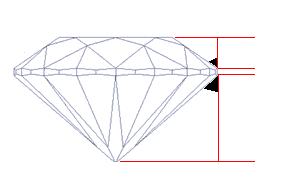- Joined
- Sep 3, 2000
- Messages
- 6,693
This is copyrighted by Michael Cowing, a buddy of mine, highly educated, technical and very much a real gemologist.
xxxxxxxxxxxxxxxxxxxxxxxxxxxxxxxxxxxxxxxxxxxxxxxxxxxxxx
Ever wonder how to find the important pavilion and crown
main angles from measurements of pavilion depth or table
size and crown height?
Here is how to get those angles with the help of a couple
of buttons on a $16 scientific calculator. It’s as easy as
1 2 3, abc do ra me.
You can use these steps to check the measurement
consistency between angle and percentage results from
devices like the Sarin, OGI or your GIA proportion scope
measurements. You may be surprised.
If you have measured or obtained the pavilion depth % and
the culet % you:
1. Double the pavilion depth %
2. Subtract the culet % from 100
3. Divide the result from step 1 by the result from step 2
and push the tan-1 button to obtain the pavilion angle
For example What exact pavilion angle corresponds to the
ideal depth percentage of 43.1% when there is no culet?
1. 43.1 times 2 equals 86.2
2. 100 minus 0 equals 100
3. 86.2 divided by 100 equals .862 and tan-1(.862) equals
40.761 degrees
So the exact pavilion depth percentage corresponding to
Tolkowsky’s 40.75 is actually 43.083%, not the rounded off
43.1%. Close enough.
If you have measured or obtained the table % and the crown
height % you:
1. Subtract the table % from 100 and divide the result by 2
2. Divide the crown height % by the result from step 1
3. Push the tan-1 button to obtain the crown angle
If you can measure the table % but not the crown height %,
the crown angle can be obtained by measuring the length of
the kite shaped, bezel facet. Divide its length by the
diamond diameter times 100 to get the bezel length %. You
then:
1. Subtract the table % from 100 and divide the result by 2
2. Divide the result from step 1 by the bezel length %
3. Push the cos-1 button to obtain the crown angle
If you have measured the table % and the bezel %, the crown
height % can be obtained by:
1. Subtract the table % from 100 and divide the result by 2
2. Square the bezel % and subtract the square of the result
from step 1
3. Take the square root of the result from step 2 to obtain
the crown height %
Find the tan-1 and the cos-1 on your scientific
calculator. On this Casio you push the shift button and
then the tan or cos to obtain the tan-1 and cos-1
Copyright © 2004 by Michael Cowing
xxxxxxxxxxxxxxxxxxxxxxxxxxxxxxxxxxxxxxxxxx
Provided as a public service to those who are in need of this information. I can''t tell you how many times I have been asked these questions and did not have the full answer.
xxxxxxxxxxxxxxxxxxxxxxxxxxxxxxxxxxxxxxxxxxxxxxxxxxxxxx
Ever wonder how to find the important pavilion and crown
main angles from measurements of pavilion depth or table
size and crown height?
Here is how to get those angles with the help of a couple
of buttons on a $16 scientific calculator. It’s as easy as
1 2 3, abc do ra me.
You can use these steps to check the measurement
consistency between angle and percentage results from
devices like the Sarin, OGI or your GIA proportion scope
measurements. You may be surprised.
If you have measured or obtained the pavilion depth % and
the culet % you:
1. Double the pavilion depth %
2. Subtract the culet % from 100
3. Divide the result from step 1 by the result from step 2
and push the tan-1 button to obtain the pavilion angle
For example What exact pavilion angle corresponds to the
ideal depth percentage of 43.1% when there is no culet?
1. 43.1 times 2 equals 86.2
2. 100 minus 0 equals 100
3. 86.2 divided by 100 equals .862 and tan-1(.862) equals
40.761 degrees
So the exact pavilion depth percentage corresponding to
Tolkowsky’s 40.75 is actually 43.083%, not the rounded off
43.1%. Close enough.
If you have measured or obtained the table % and the crown
height % you:
1. Subtract the table % from 100 and divide the result by 2
2. Divide the crown height % by the result from step 1
3. Push the tan-1 button to obtain the crown angle
If you can measure the table % but not the crown height %,
the crown angle can be obtained by measuring the length of
the kite shaped, bezel facet. Divide its length by the
diamond diameter times 100 to get the bezel length %. You
then:
1. Subtract the table % from 100 and divide the result by 2
2. Divide the result from step 1 by the bezel length %
3. Push the cos-1 button to obtain the crown angle
If you have measured the table % and the bezel %, the crown
height % can be obtained by:
1. Subtract the table % from 100 and divide the result by 2
2. Square the bezel % and subtract the square of the result
from step 1
3. Take the square root of the result from step 2 to obtain
the crown height %
Find the tan-1 and the cos-1 on your scientific
calculator. On this Casio you push the shift button and
then the tan or cos to obtain the tan-1 and cos-1
Copyright © 2004 by Michael Cowing
xxxxxxxxxxxxxxxxxxxxxxxxxxxxxxxxxxxxxxxxxx
Provided as a public service to those who are in need of this information. I can''t tell you how many times I have been asked these questions and did not have the full answer.









300x240.png)